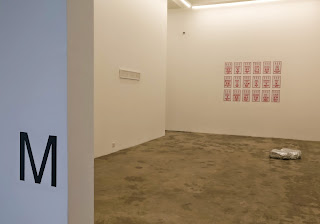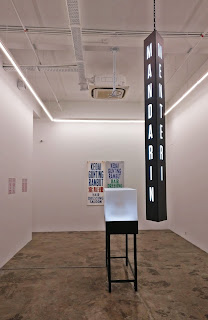M @ A+ WORKS of ART
“M” recalls ‘M’, a memorable work by Tan Zi Hao I last saw three years ago. The found-object aesthetic extends to shop signs hung here, where a pawnbroker’s signage – with its four languages and prominently circled 當 ideogram – greets the gallery visitor. Shown next is a paperback Susur Galur Bahasa Melayu by eminent linguistics scholar Asmah Haji Omar, placed before three similar book covers where the words “Bahasa Melayu” is translated into Chinese, then Jawi, then “Bahasa Malaysia”. The Chinese rendition is beguiling; While “Bahasa 巴哈薩” gets a direct phonetic translation, the rendering “Melayu 巫來由” now implies “Malay origins”, due to the process of translating Latin alphabets into monosyllable Chinese characters. Although illegible, the Jawi translation reminds me of the Arabic script adapted to write the Malay language, when Islam arrived at this region in the 12th century. “M” for mortgage?
 |
| Exhibition snapshot at gallery entrance |
Therein lies the theme explored in these exhibits, which Eddin Khoo succinctly describes on radio as, “what happens when language, which predates nation, meets nation, and begins to serve the interest of nation.” Approaching the silver ‘Bhāṣā Jīva Vaṃśa’ inscription stone, its cracked halves suggest broken precepts. To quote sociologist Tham Seong Chee from a 1981 essay, “(l)anguage, according to a Malay saying, is “the soul of the nation” (bahasa jiwa bangsa). It is interesting to note that the word bahasa etymologically Sanskrit means both “language” and “manners”, so that bahasa in effect is associated with or implies “speech and breeding” or “speech as indicating breeding.”” Bahasa jiwa bangsa, has been upheld by the government agency Dewan Bahasa dan Pustaka since its official formation in 1956, as the slogan for promoting the National Language. “M” for Moses?
 |
| Susur, Galur, dan Bahasa Melayu (2017) |
“”M” provokes and frustrates us at every utterance (…) In our infantile babbling of “ma-ma-ma”, we pronounce the bilabial nasal…”, Zi Hao states in both exhibition statement and BFM interview. My first impression of “M” as exhibition title, however, is the capital letter’s pronunciation “em”. “M” as the sound of dithering. “M”, James Bond’s superior. “M” in the play M. Butterfly. “M” as a sign for male toilet. “M” the 1931 Fritz Lang film. “M+” the new museum in Hong Kong. That I did not think of “Malaysia” or “multilingualism”, denotes the interpretation gap between artist and spectator. Both topics are explicitly confronted in two older works – one heavily-subtitled Negaraku music video, and “The Danger of Translation Lies in That Which is Left Untranslated”, where each of the eighteen metal plates address specific issues in the Malaysian context. “M” for microwave?
 |
| Writing is a Strange Thing (2017) |
The familiar silkscreened form is repeated in two new brilliantly-titled works. ‘Clowning/Crowning’ refers to political satire, while ‘Writing is a Strange Thing’ quotes Claude Lévi-Strauss from his travel memoir Tristes Tropiques. The anthropologist writes in the same chapter, that “(w)riting may not have sufficed to consolidate human knowledge, but it may well have been indispensable to the establishment of an enduring dominion.” Nevertheless, correlating this text with Zi Hao’s “Pen-Datang” is insufficient; The increasingly shorter word of “datang” upon each translation, stirs endless fascination too with its aesthetic design. Representation remains an area of improvement for the conceptual artist, whose use of visual cues is lacklustre in thematically strong works, such as the three-sided light enclosure emblazoned with “Mantra, Menteri, Mandarin”. “M” for mimesis?
 |
| Exhibition snapshot |
Language aside, this logocentric lamppost indicates a more prominent theme in this exhibition, i.e. the act of addressing. Four printed addresses are shown translated sequentially in ‘Addressing Home’, from Bahasa Malaysia to Chinese to English to Bahasa Melayu. The slippages in transliterations are summarily presented, delightful as its result may be – Mekar Berseri sounds like a more attractive township than Seri Kembangan. Along with the accompanying work ‘Unaddressing Home’, one’s physical dwelling is rendered as a sovereign claim by the nation, whereby the utility of language does not correspond to the immediate commune, but to an imagined polity. A starting point for both works is the use of Bahasa Malaysia in public signboards and road names, which is stipulated in the National Language Act 1963/67 and local council by-laws. “M” for mail?
 |
| Addressing Home (2017) |
Looking at the four signboards recreated on galvanized iron sheets, my reaction and subsequent interpretations fail to reconcile with Zi Hao’s statement claiming “(n)ot only do multilingual signages hint at the nature of Malaysia’s linguistic landscape, more insidiously, they betoken some form of inequality and exploitation in the name of language.” Surely, commercial intentions direct business owners in the design of their signboards? Malay is compulsory, English sounds privileged, and Chinese is to address the main customer base. By asserting his observations, the artist puts himself at the mercy of his own critique, that the written language as an approach to convey ideals is an inadequate endeavor regardless. Addressing an issue, its corresponding artwork & presentation, and audience perception, is a tricky balancing act. Perhaps, more “M”-biguity is needed. “M” as ‘art coefficient’?
 |
| That Which Exploits, Unites (2017) |
“In the creative act, the artist goes from intention to realization through a chain of totally subjective reactions. His struggle toward the realization is a series of efforts, pains, satisfaction, refusals, decisions, which also cannot and must not be fully self-conscious, at least on the esthetic plane. The result of this struggle is a difference between the intention and its realization, a difference which the artist is not aware of. Consequently, in the chain of reactions accompanying the creative act, a link is missing. This gap, representing the inability of the artist to express fully his intention, this difference between what he intended to realize and did realize, is the personal ‘art coefficient’ contained in the work. In other words, the personal ‘art coefficient’ is like an arithmetical relation between the unexpressed but intended and the unintentionally expressed.”
– The Creative Act (1957), Marcel Duchamp, “The Writings of Marcel Duchamp”, ed. Michel Sanouillet and Elmer Peterson, 1973
 |
| Bhāṣā Jīva Vaṃśa (2017) |
Comments
Post a Comment